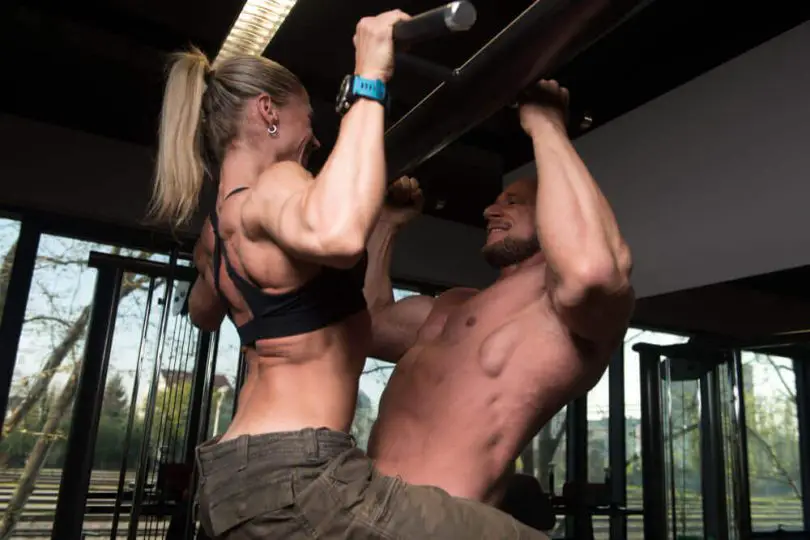Consider bodyweight training if you need a low-cost, high-efficiency workout. For years, it’s been a part of my routine, and I attribute my good health and fitness to it. Find out how long you should devote to your bodyweight training and what tools are ideal for it here.
The following example will show you how long a bodyweight workout should last. You don’t need 20 minutes a day to see results from exercise; even 10 minutes a day will do the trick. Get some dumbbells or a weighted vest if you think this would help you or someone you know get in shape without leaving the house.
A good bodyweight workout can be done in as little as 10 minutes.
Ten minutes is all you need for a solid workout using only your bodyweight. You read it correctly; to grow strong and fit, you need not need a membership to a gym or any equipment.
Workouts that use only your body weight require very little in the way of space and equipment, making them ideal for anyone just starting in the fitness world. Additionally, many of them do not call for any specialized knowledge or abilities (such as weightlifting). You might even be able to carry one out in your own home!
If you are unable to use weights or machines at the gym due to an injury or another reason, then a bodyweight routine might be the perfect solution for your needs. Not only would it save you money on monthly membership fees, but it would also be perfect for your needs.
An exercise using only your body weight can be completed in as little as ten minutes. How to do it:
– Select the exercises that you wish to accomplish, and then determine the total number of repetitions that you will complete for each exercise. If you are performing a circuit that includes three sets of pushups, pullups, and squats, for instance, this will imply performing three repetitions of each exercise and only resting in between the exercises.
– Before beginning your workout, it is important to begin by performing some type of cardiovascular activity for three to five minutes.
Are 10 minutes of exercise a day enough?
I know, that doesn’t seem like much, right?
However, let’s rephrase the inquiry. If you don’t believe that ten minutes can change anything, ask yourself this: Does that sound like it could bring me where I need to be? The question is, “Will I be able to achieve my goals with it?”
Can it? Why, yes, of course, it can!
It’s not the last destination or solution to all of your fitness problems. It shouldn’t be like that.
Nonetheless, it’s sufficient to motivate you to get up and out of bed and into action. When you’re done, you’ll feel accomplished.
On a hectic day when you don’t have time for anything else, that’s all you need to feel revitalized. Just looking at it might make you feel like you’ve been playing, in nature, or having a good time. Plus, that’s enough to make you ache the following day.
What’s more, if you extrapolate it over a full year, you’ll have logged an additional 60 hours of exercise that you otherwise might not have gotten to! Every day’s extra ten minutes can make a huge difference over time.
The effectiveness of a 10-minute workout depends on three main factors:
-
Doability
Even on the days when you don’t feel like doing it, ten minutes seems manageable. Honestly, how can you tell yourself that you don’t have 10 minutes to get moving? The vast majority of the time, no. You’ll be more inclined to follow through and do it because of this.
-
Intensity
If you dedicate just 10 minutes per day, you’ll have more time to devote to whatever it is you’re doing. Would you walk more quickly if I instructed you to do it for 10 minutes instead of 60?
Assumingly, you would. Your body has evolved to the way you now live, therefore that’s crucial information to have. It is programmed to do the things it needs to do daily to keep you alive.
It’s possible that doing the same thing, at the same speed, with the same intensity every day (like walking the dog), will improve your mobility and how you feel, but it won’t force your body to alter or adapt. There’s no need for it to, given we’re already operating at or below its capability.
You can give your body what it needs to keep adapting, developing muscle, and boosting its ability by working out intensely for 10 minutes.
-
Sufficiency
You only need ten minutes per day to get a fantastic workout. It’s a common misconception that you need to devote at least 30 minutes to physical activity for any noticeable results.
And if possible, even an hour would be better. (Think about it: when was the last time you saw a commercial for a 10-minute workout class? (…or consulted a coach for ten minutes.) There’s no reason why even 30 or 60 minutes wouldn’t help you.
The fact that a full workout may be completed in just 10 minutes. However, it all comes down to determination; you need to want it. Do not mistake this for a frivolous attempt at physical activity. If you want to succeed, you have to be willing to give it your all on that particular day.
I have a workout for you to try if you are not yet convinced. A sidewalk and a stopwatch are all you need for this workout, but you should give it your all.
Warm up first with 3 to 5 minutes of cardio.
Now that you are familiar with the fundamental exercises, let’s talk about how long a workout with only your body weight should be.
There are a lot of gyms and fitness groups that consider this when they create their programs, but if you’re working out at home or in your own space where there isn’t any equipment accessible, then it’s up to you to pick what exercises are most effective for your body.
Before beginning another set of exercise movements, it is essential to not only warm up those muscles but also to warm up your heart rate.
This is the key to success here. Both of these organs will be better prepared for high-intensity activities like burpees and mountain climbers if you do this, as it will help prevent them from overheating and sustaining damage as a result (and other forms).
Do 2 or 3 circuits of the following exercises, doing each move for 1 minute and resting only as needed.
Although circuit training is an excellent method for getting a workout in, it is not appropriate for everyone. If you’ve never done circuit training before, consider the following advice:
- Perform each exercise for a total of thirty seconds before moving on to the next action.
- Only take breaks between sets that are as long as you need to recover.
For instance, if you perform each exercise for three minutes, you should give yourself a break of two minutes between exercises and one minute after each action (for a total of 4 minutes).
Cool down with a few minutes of stretching, especially for your hips and lower back.
It is essential to take some time to stretch and cool down after a workout. Stretching can help alleviate muscle tightness and improve flexibility, both of which can contribute to a reduction in the likelihood of injury.
In addition, research has shown that stretching can enhance the quality of sleep in both healthy persons and people who suffer from chronic pain problems such as arthritis or back pain.
It also speeds up recovery from workouts by lowering inflammation, which means you are less likely to sustain an injury while participating in sports or other activities that put your body under stress or pressure (think: lifting weights).







